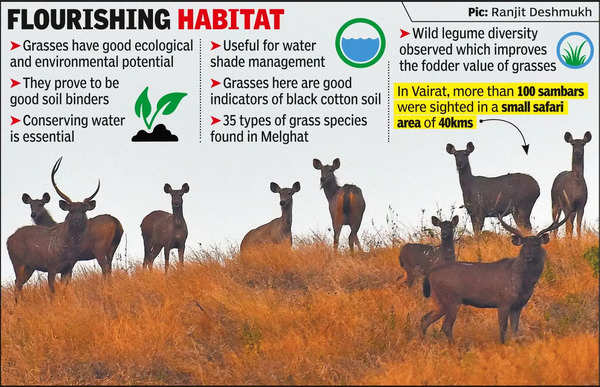The successful voluntary relocation of villages has created a win-win situation for people and wildlife.Of the 33 villages in the core area, 19 have been relocated, 6 are in the process, and the relocation of 8 villages in the Sipna and Gugamal divisions is awaited.


Melghat regained over 2,312 hectares of prime area after relocating villages in the Akot and Gugamal divisions. Today, wild animals rule over territories, which once dominated by humans.
Our area is either maintained or is in the process of being preserved as grasslands and woodlands, said Deputy CF (Akot) Jey Kumar.
A recent visit to the relocated villages of Koha, Kund, Vairat, Pastalai, Bori, Dhargad, Gullarghat, Kelpani, Somthana, and Barukheda revealed how elusive tigers and their preys are flourishing in the Satpura range.
In Vairat, more than 100 sambars, besides barking deer, jackals, gaurs, wild boars, sloth bears, and peacocks were sighted in a small safari area of over 40kms. The presence of tigers confirmed protection and habitat management were working in the undulating landscape.
Similarly, in Gullarghat meadows, separate herds of over 100 gaurs were recorded on both sides of the tourism route, and groups of spotted deer in the shining Bori-Dhargad meadows.
Jey Kumar said that making the core area of tiger reserves inviolate is one of the prime requirements for population recovery of prey and predator. “Relocation, followed by strict protection, has allowed natural processes of recovery to begin, which is evident from rising numbers of prey and predator,” he said.
“If relocation of remaining villages is achieved and protection is maintained, MTR could be one of the tiger reserves that ticks most of the right boxes in scientifically conserving a tiger landscape,” Kumar added.
As per NTCA’s all-India Tiger Estimation (AITE)-2022 phase IV report, the tiger population of MTR is estimated at 56 and that of leopards at 181. Besides, the sambar density is 2.69/sqkm and that of chital is 1.56/sqkm.
“Melghat seems to be transforming from the ‘Land of elusive tigers’ to the ‘Land of tigers’, thanks to the grass biodiversity and meadow development,” says wildlife biologist Manish Dhakulkar.
DyCF Sumant Solanke said that Vairat is now a wildlife hotspot. “Even on odd days, a sizable number of tourists go for safari,” he said.
“The cultivated lands in rehabilitated villages were converted into good grasslands. These interventions improved herbivore grazing, hiding and breeding,” added Solanke.
“Free movement of herbivores followed by carnivores has significantly improved. The carrying capacity of grasslands and utility index of grassland is increasing consistently,” added Kumar.
CCF & field director of MTR Jayoti Banerjee said, “The crux of any good wildlife habitat is good grasslands for herbivores that links the nutrition food-web to better survival of carnivores. Apex species will flourish and protect prime habitats only if the food chain below functions. The key is grass.”
“It took almost five decades and a groundbreaking work of village relocation, meadow development, and protection to yield results. Tiger sightings are common now, especially in south Melghat around Bori-Dhargad, Gullarghat, Somthana & Shahanur blocks,” said director of Bombay Natural History Society Kishor Rithe.
Besides, the role of grass expert and professor Gajanan Muratkar, who has been guiding Melghat officials and staff on meadow development since 2011, was crucial.
On the drastic change, Muratkar says, “Pre-2000, the core area of Melghat was occupied by several villages but after 2011 they were relocated. This checked grazing pressure on forest. Besides, enrichment of fodder grass and major interventions by the frontline staff is yielding results.”